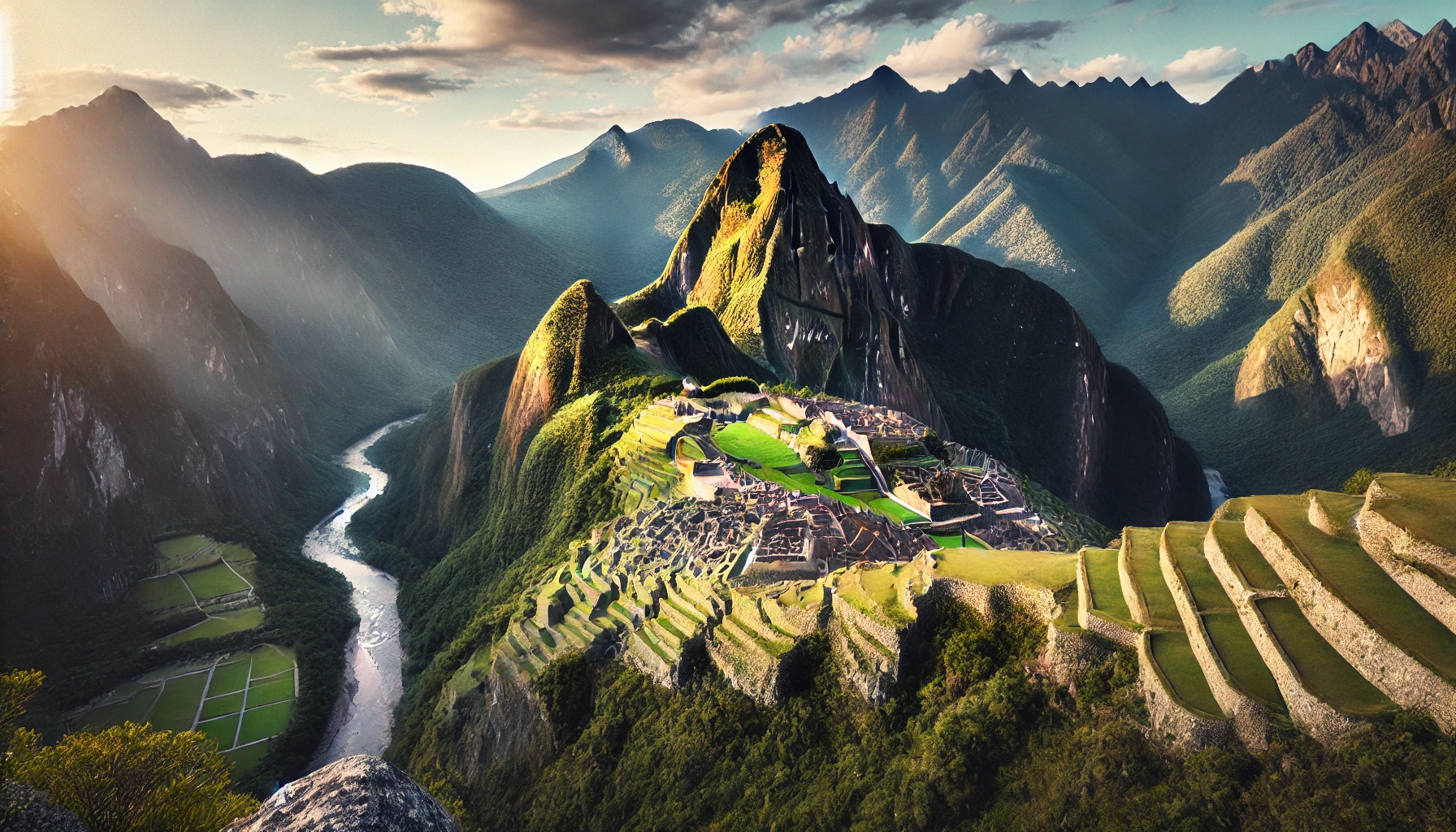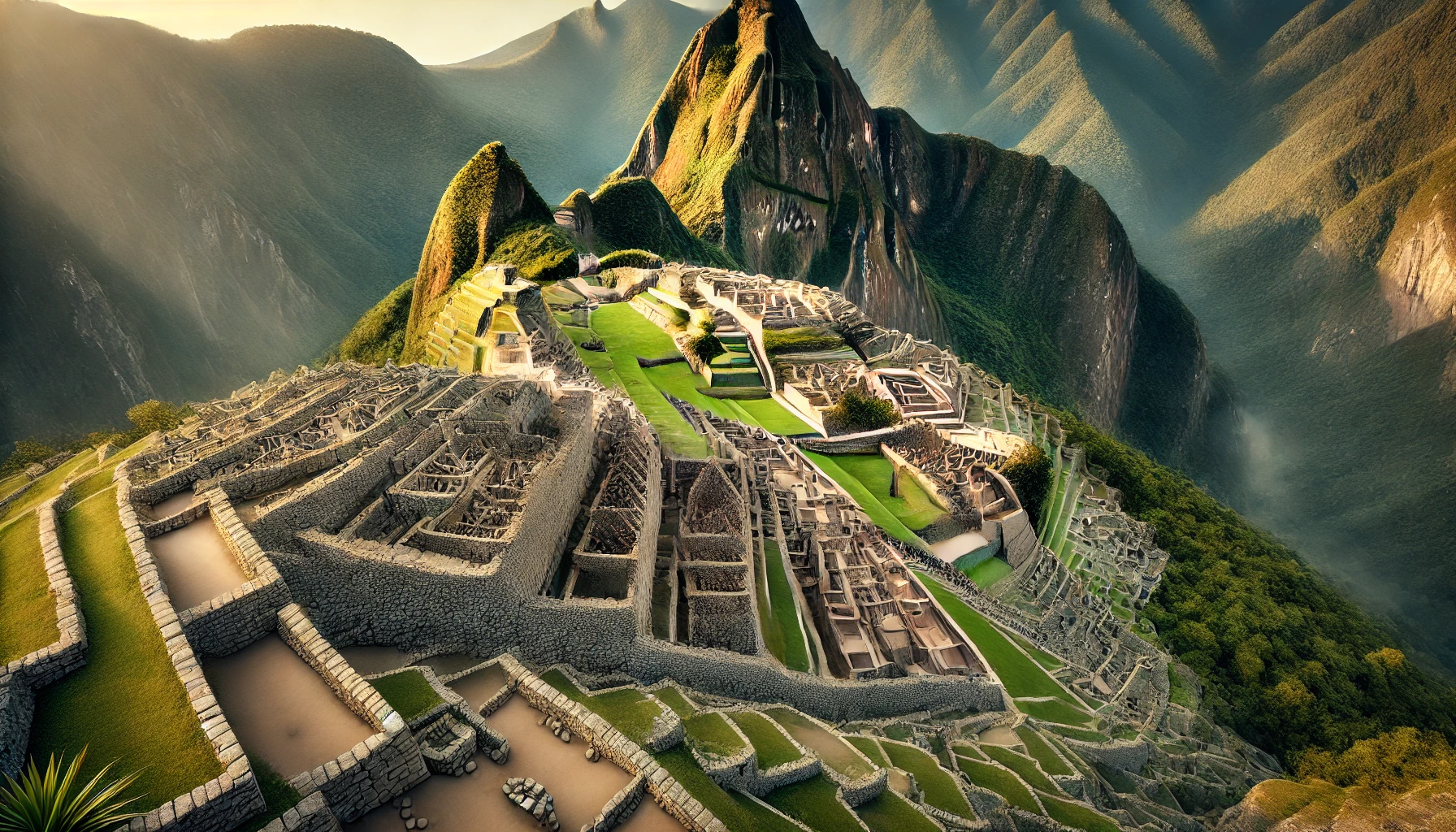Machu Picchu is one of the most famous archaeological sites of the Inca Empire, located in the Andes Mountains of Peru. Built by the Incas in the 15th century, Machu Picchu sits at an altitude of 2,430 meters and is inscribed on the UNESCO World Heritage list. This ancient city draws global attention with its engineering marvels, agricultural terraces, religious structures, and unparalleled natural beauty.
Where is Machu Picchu Located?

Machu Picchu is situated in southern Peru, high in the peaks of the Andes Mountains, near the Amazon rainforest. This ancient city lies in the Cusco region of Peru, nestled within the bends of the Urubamba River at an altitude of approximately 2,430 meters above sea level. Its unique location provided it with natural seclusion and protection, allowing it to remain hidden from Spanish conquistadors for many years.
Geographical Location and Climate
It is located in the Cusco region of Peru, near the Amazon rainforest. Its position atop the Andes Mountains means it experiences a high-altitude mountain climate. The average temperature ranges from 12 to 15 degrees Celsius throughout the year, with heavy rainfall occurring primarily between November and March. To adapt to the challenging terrain, the Incas developed advanced terrace farming and water management systems.
The History of Machu Picchu
Construction and the Inca Era
Machu Picchu is believed to have been constructed around 1450 by Inca Emperor Pachacuti Yupanqui. The city served as a religious and administrative center while also playing a significant role in agriculture, astronomy, and trade. The stonework used in its construction stands as a testament to Inca architectural ingenuity. The precisely interlocked stones, assembled without the use of mortar, showcase the engineering prowess of the Inca civilization.
Spanish Conquests and Its Mysterious Abandonment
During the 1530s, as the Spanish began conquering South America, many Inca settlements fell under their control. However, Machu Picchu remained hidden due to its remote location, avoiding inclusion in Spanish records. The city was mysteriously abandoned and eventually engulfed by dense forest, remaining forgotten for centuries.
Rediscovery: Hiram Bingham and the 20th Century
Machu Picchu was rediscovered in 1911 by American explorer Hiram Bingham. Guided by information from local villagers, Bingham reached the site during an expedition for Yale University and introduced this remarkable archaeological treasure to the world. His discovery brought global attention to Machu Picchu, leading to increased archaeological research and excavation efforts.
The Structure and Sections of Machu Picchu

Machu Picchu consists of various sections, each serving a distinct purpose. Broadly, the city is divided into two main areas: the agricultural zone and the urban zone.
Agricultural Terraces
The agricultural terraces surrounding Machu Picchu are a testament to the Incas’ mastery of farming. These terraces not only created arable land for cultivation but also managed water flow to prevent erosion.
Religious and Political Structures
One of Machu Picchu’s most iconic structures is the Temple of the Sun, which was used primarily for astronomical observations. Alongside the Temple of the Sun, religious structures like the Sacred Plaza and the Temple of the Three Windows provide insight into Inca spiritual beliefs. These buildings served as centers for worship and celestial observations.
Royal Residence and Living Quarters
The royal residence, situated at a higher elevation, was intricately designed and built with care. The city also includes stone structures used for daily living, storage facilities, and warehouses for agricultural products. These features highlight that Machu Picchu was not only a ceremonial center but also a functional living space.
Cultural and Archaeological Significance of Machu Picchu
Machu Picchu is one of the most important ancient cities that preserves the essence of Inca culture and technology. The intricate stonework, agricultural techniques, and astronomical knowledge displayed in Machu Picchu reflect the advanced capabilities of the Inca civilization. Its discovery resonated worldwide, making significant contributions to the field of archaeology.
Visitation and Conservation Efforts
Machu Picchu welcomes thousands of tourists annually. However, this high volume of visitors has necessitated protective measures to ensure the site’s preservation. Peruvian authorities have implemented visitor limits to safeguard the area. Additionally, UNESCO and various archaeological organizations are developing sustainable tourism practices to protect the ancient city for future generations.
What is the Primary Purpose of Visiting Machu Picchu?

The main purpose of visiting Machu Picchu is to witness the remarkable achievements of the Incas in engineering, architecture, astronomy, and agriculture while gaining profound insights into their culture. This ancient city, surrounded by towering mountains, offers breathtaking natural vistas, making it an essential destination for nature, history, and archaeology enthusiasts. Below are the key reasons for visiting Machu Picchu:
1. Witnessing History and Archaeology
Machu Picchu showcases the architectural brilliance and engineering expertise of the Incas, featuring intricate stonework and complex structures. Visitors can explore iconic landmarks such as the Temple of the Sun, the Temple of the Three Windows, and the Royal Residence, gaining a deeper understanding of Inca religious, political, and social structures. Built during the height of the Inca Empire, Machu Picchu provides invaluable insights into this ancient civilization.
2. Discovering Architecture in Harmony with Nature
Despite its location in rugged mountain terrain, Machu Picchu was constructed in perfect harmony with its natural surroundings. The agricultural terraces were designed to prevent erosion and support sustainable farming. Visitors can examine these terraces and water management systems, experiencing the Incas’ environmentally conscious way of life.
3. Experiencing a Spiritual and Cultural Journey
Machu Picchu served as a spiritual and religious center for the Inca civilization. Structures like the Temple of the Sun were used for celestial observations and sacred rituals. Visitors often feel a profound spiritual connection within this historical atmosphere, embarking on an introspective journey through time.
4. Trekking and Adventure
Reaching Machu Picchu often involves trekking the famous Inca Trail, a thrilling route for adventure seekers and nature lovers. The trail passes through mountains, forests, and valleys, offering unparalleled scenic beauty. This unique journey enhances the overall experience, making the arrival at Machu Picchu even more memorable.
5. Cultural and Tourism Significance
As one of Peru’s most iconic symbols, Machu Picchu is a vital hub for cultural and economic activity. Thousands of visitors from around the globe engage with Peru’s rich culture, cuisine, and traditions while interacting with local communities, fostering cultural exchange and understanding.
Visiting Machu Picchu is not just about exploring an ancient city but also about connecting with the spirit of the Inca civilization. It offers an unparalleled blend of history, nature, and culture, leaving visitors with a lasting impression of its timeless beauty and profound significance.
Best Time to Visit

The best time to visit Machu Picchu is during Peru’s dry season, which spans from May to September. During this period, the weather is drier and clearer, allowing visitors to enjoy a more comfortable experience and take in the stunning natural beauty of the region. However, these months also see the highest tourist traffic. Below are the details for visiting Machu Picchu during different times of the year:
1. Dry Season: May to September
These months mark the driest period in the Andes region and are the busiest time. With sunny weather and clear skies, the views of iconic landmarks like the Sun Temple, Royal Residence, and agricultural terraces are particularly striking. June and July are the peak tourist months, so those seeking a quieter visit might prefer May or September.
Advantages of the Dry Season:
- Clear and sunny weather.
- Ideal lighting conditions for photography.
- Perfect for hiking and Inca Trail tours.
Disadvantages of the Dry Season:
- Crowded attractions due to high tourist numbers.
- Increased accommodation and tour prices.
2. Transitional Periods: April and October
April and October fall between the rainy and dry seasons. While these months are generally dry, occasional short rain showers may occur. Despite this, the rainfall is minimal and does not obstruct the views. With fewer tourists, these months offer a more serene experience at Machu Picchu.
Advantages of Transitional Periods:
- Moderate tourist crowds.
- Favorable weather conditions.
- Quieter and more relaxed atmosphere.
Disadvantages of Transitional Periods:
- Unpredictable weather changes.
- Slight chance of rain.
3. Rainy Season: November to March
The rainy season, lasting from November to March, is the least crowded time of the year at Machu Picchu. Heavy rains can make activities, especially hiking the Inca Trail, more challenging. The Inca Trail is entirely closed during January and February due to severe weather conditions. During this time, taking the train to Machu Picchu is a safer option. Despite the rain, the lush greenery and reduced crowds make it an appealing choice for those seeking tranquility.
Advantages of the Rainy Season:
- Peaceful atmosphere with fewer tourists.
- Vibrant green landscapes.
Disadvantages of the Rainy Season:
- Heavy rain and muddy trails can make exploration difficult.
- The Inca Trail is closed in January and February.
- Reduced visibility due to fog and mist in certain areas.
General Tips and Recommendations
- Visit Early Morning: Arriving between 6:00 and 8:00 AM is recommended to avoid the busiest hours.
- Plan for the Inca Trail: For those planning to hike the Inca Trail, the dry season is ideal, but permits must be arranged in advance.
- Be Prepared: Protective gear such as sunscreen, hats, and raincoats is essential, as weather conditions in the Andes can change quickly.
Machu Picchu offers unique beauty in every season, making it a must-visit destination. Don’t miss the opportunity to experience this incredible historical and natural wonder!
